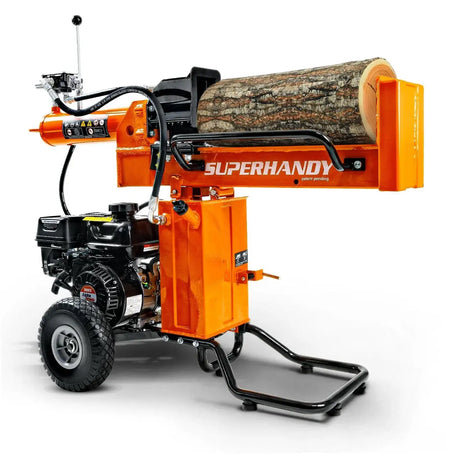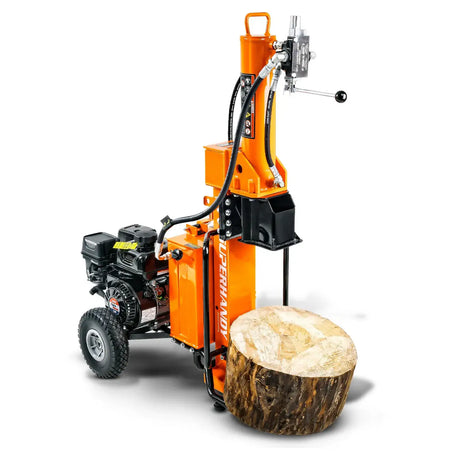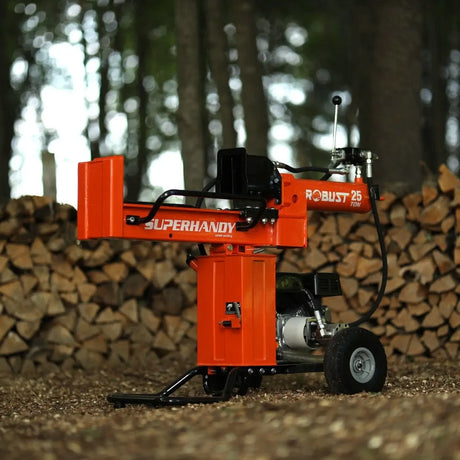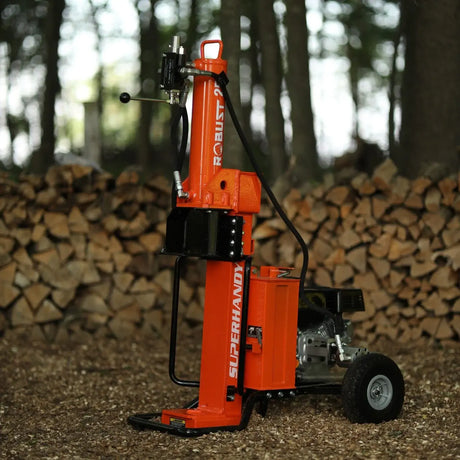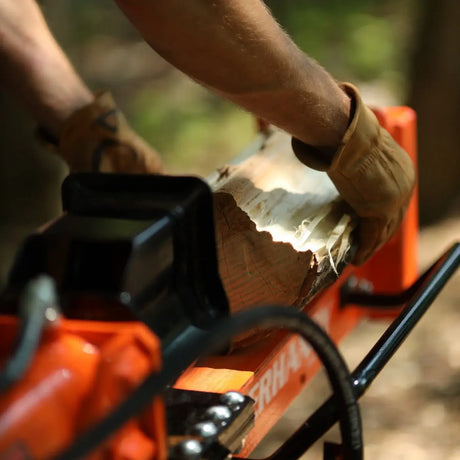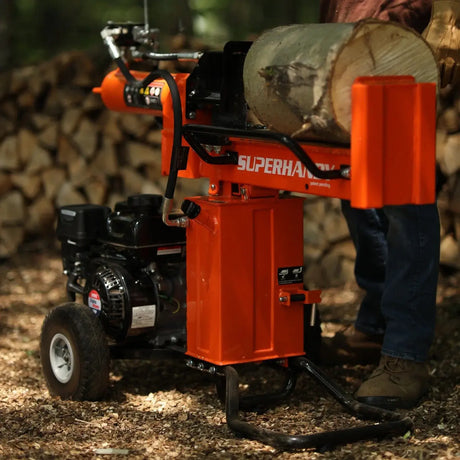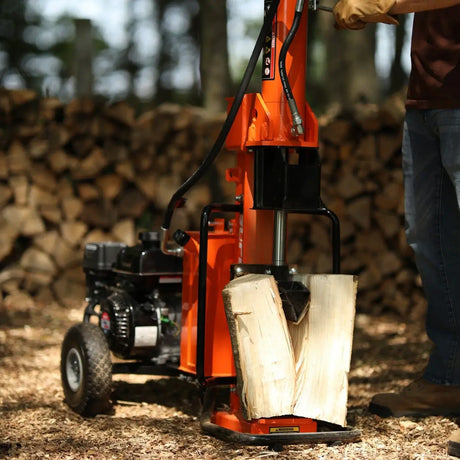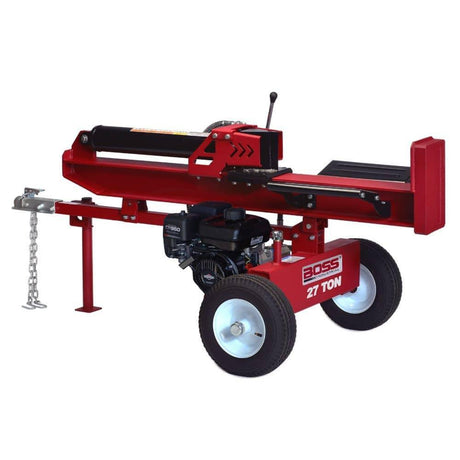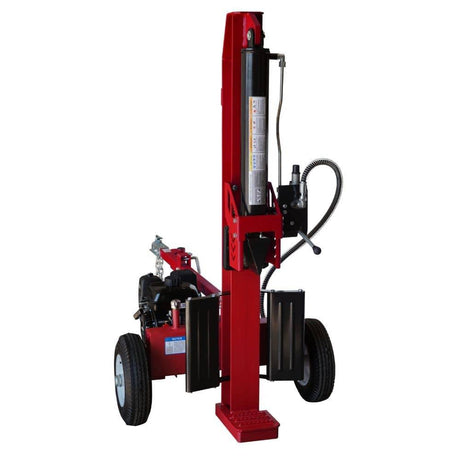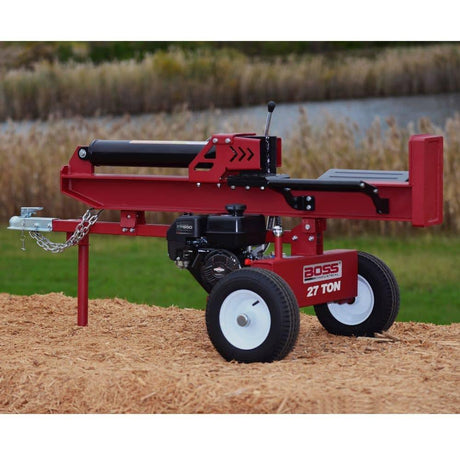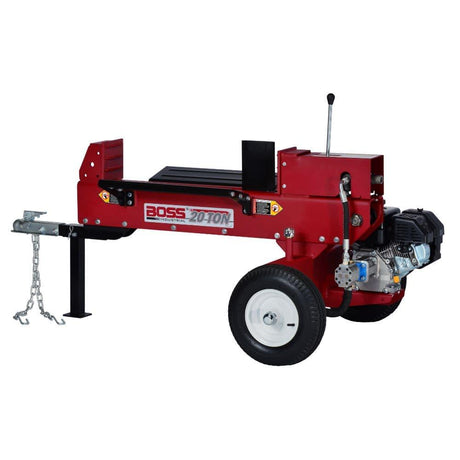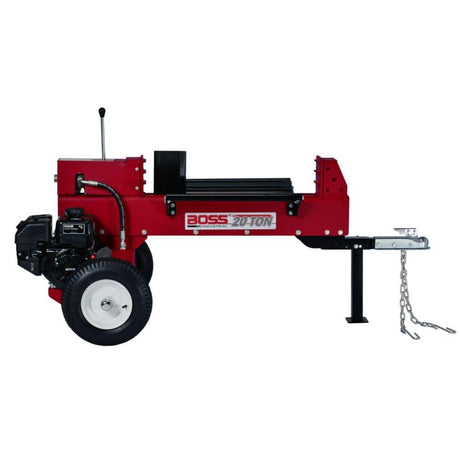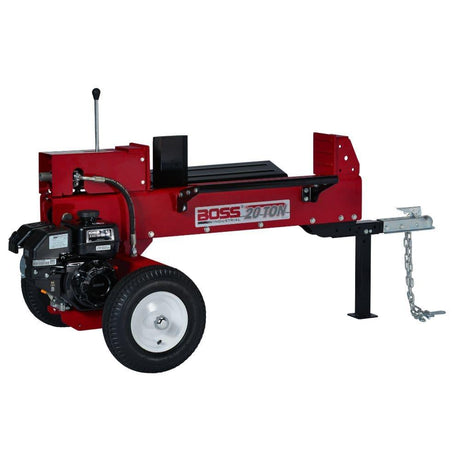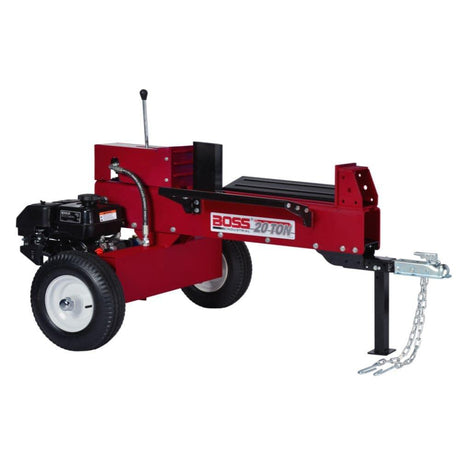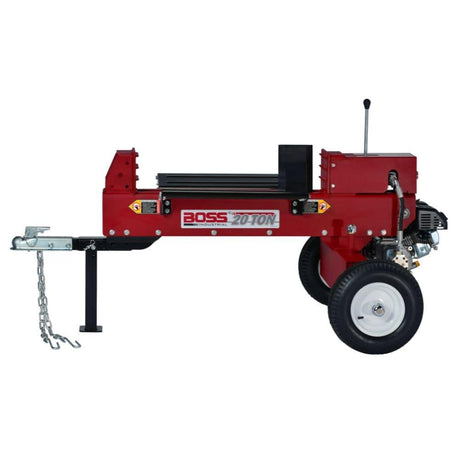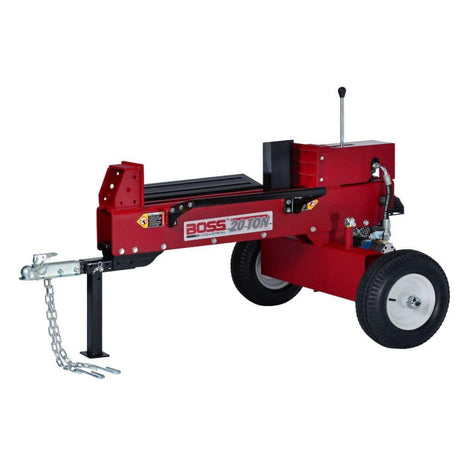SuperHandy
SuperHandy 25 Ton Gas Log Splitter - 7HP 209CC, 20" Max Log Length
$2,088.90Unit price /UnavailableBoss Industrial
Boss Industrial WD37T 37 Ton Horizontal/ Vertical Gas Log Splitter
$2,359.00Unit price /UnavailableBoss Industrial
Boss Industrial WD27T 27 Ton Horizontal/ Vertical Gas Log Splitter
$1,599.00Unit price /UnavailableBoss Industrial
Boss Industrial GD20T24 20-Ton Dual Action Gas Log Splitter
$1,899.99Unit price /UnavailableBoss Industrial
Boss Industrial GD16T21 16-Ton Dual Action Gas Log Splitter
$1,669.99Unit price /Unavailable
Shop Vertical Log Splitters for Heavy-Duty Wood Splitting
What Makes a Vertical Log Splitter Unique?
A vertical log splitter (also known as an upright log splitter or stand-up splitter) is built to handle the biggest, heaviest logs—without the need to lift them onto a beam. Instead of loading logs horizontally, you roll them into place while the splitter is in vertical position, and let gravity work with you.
What sets it apart:
- Ergonomic log splitting solution for large rounds
- Reduces strain—no lifting, just rolling
- Designed for thick, unmanageable logs you can't lift onto horizontal units
- Can split logs up to 36"+ in diameter when properly powered
If you're regularly dealing with oversized hardwoods like oak, hickory, or maple, this is the machine you want.
When to Choose a Vertical Over a Horizontal Model
A vertical wood splitter isn't always necessary—but in the right context, it's the better choice by far. Choose vertical if:
- You're splitting logs that are too heavy to lift
- You want to minimize bending and back strain
- You're working outdoors with irregular or dense rounds
- You split wood solo and need to roll instead of lift
Many pros also prefer dual-position log splitters (horizontal + vertical) for flexibility, but if your main issue is handling massive logs, a vertical-only operation setup keeps things simple and efficient.
Who Needs a Vertical Log Splitter?
Vertical models are designed for homeowners with large lots, firewood businesses, and anyone managing hardwoods or thick timber regularly. You'll benefit most if you:
- Split outdoor firewood in large volumes
- Work with log rounds over 100 lbs
- Need a firewood splitter for big hardwoods
- Prefer a hydraulic vertical splitter that can be operated solo without heavy lifting
They're also great for older users or anyone with limited mobility, since they allow for splitting in an upright position without constant lifting or awkward loading.
Explore Our Best-Selling Vertical Log Splitters
High-Tonnage Models for Large, Dense Logs
Our top vertical units are built for serious force. Whether you're splitting green oak or frozen maple, you'll want something in the 25 to 35-ton range for smooth, consistent results.
- Designed for vertical log splitting posture advantages
- Most come with a steel wedge splitter and a 2-stage gear pump for maximum pressure
- Easily breaks through knotted or stringy rounds
If you're asking, can a vertical log splitter handle large logs?—the answer is yes, if you've got the tonnage.
Gas-Powered vs. Electric Vertical Log Splitters
Both types exist, but here's the deal:
- Vertical gas-powered splitters:
- Built for outdoor use, remote areas, and heavy-duty logs
- Offers higher tonnage and speed
- Ideal for firewood businesses or large rural properties
- Vertical electric splitters:
- Best for light-duty jobs in garages or near a power outlet
- Cleaner, quieter, and low-maintenance
- Good for residential use and occasional splitting
If you're splitting big rounds in the field, go gas. For smaller, controlled environments, vertical electric splitters can get the job done.
Residential vs. Commercial Vertical Units
We carry models that serve both ends of the spectrum.
Residential units:
- Compact and easy to tow
- Moderate tonnage (22-28 tons)
- Best for homeowners needing a vertical splitter for limited space
Commercial units:
- Built for long hours and daily operation
- Heavy-duty steel components, high-tonnage capacity, and reinforced beams
- Ideal for firewood processors, tree services, or outdoor wood yards
No matter your use, all models feature vertical hydraulic splitter systems with safety in mind.
Log Diameter Capacity, Safety Features, and Steel Frame Design
Key features to expect in our best vertical models:
- Log diameter capacity: Up to 36" with proper tonnage
- Safety lock system: Prevents accidental operation
- Pivoting operation arm: Easier for solo use
- Steel beam and vertical rail: Durable under extreme pressure
- Log cradle or catcher: Keeps logs stable while splitting
Every machine is designed for control, comfort, and raw splitting power—especially when you're dealing with massive hardwood logs in vertical position.
Choosing the Right Vertical Log Splitter
Tonnage Guide: What You Need for Oversized Rounds
If you're shopping for a vertical wood splitter, tonnage is the first thing to lock in. It's what determines whether your splitter will power through big hardwood rounds—or stall out halfway.
Here's a simple breakdown:
- 20-25 Ton: Suitable for semi-seasoned wood, smaller hardwood rounds
- 27-30 Ton: Great for large, dense logs (oak, hickory, maple)
- 35+ Ton: Built for frozen, knotted, or twisted rounds—ideal for firewood pros
For anything over 18" diameter, go with at least 27 tons of hydraulic force. Don't try to push undersized machines on oversized logs—you'll wear out the pump, slow down your cycles, and lose your patience.
Tip: Look for a hydraulic vertical splitter with a 2-stage gear pump. It'll deliver both speed and torque when you need it.
Portability and Setup Considerations
Vertical doesn't mean immobile—but it does mean you'll need a few extras if you're moving it often.
Key things to look for:
- Towable vertical splitter setup with a hitch and rugged wheels
- Balanced frame design so it doesn't tip while towing or operating
- Vertical-only models tend to be bulkier, so make sure your workspace can handle the footprint
- Look for foldable handles or pivoting arms if you're working solo
If you're splitting in different spots around your property, portability matters just as much as power. A good vertical splitter for outdoor use should roll smooth and set up fast.
Operating Tips and Safety Add-Ons to Look For
Vertical splitters are powerful, but they require focus and control—especially when working alone. Here's what keeps you safe and efficient:
- Log cradle or catcher: Keeps rounds stable during the split
- Safety lock system: Prevents unintentional activation
- Steel beam and vertical rail: Ensures consistent tracking under heavy loads
- Pivoting operation arm: Easier access when switching between rounds
- Clear ground space: Keep your footing secure—no slippery or uneven surfaces
Always split with both hands away from the wedge path, and if your model has one, engage the safety lever between every cycle. These machines don't forgive sloppy setups.
Vertical vs. Horizontal Log Splitters: Which Is Better?
Key Differences in Use and Performance
Both styles have strengths—it's really about what you need.
| Feature | Vertical Splitter | Horizontal Splitter |
|---|---|---|
| Best for | Oversized, heavy logs | Small to mid-size rounds |
| Log loading | Roll logs into place | Lift logs onto beam |
| User position | Standing upright | Standing or bending |
| Power needs | Higher tonnage | Moderate tonnage |
| Setup space | Needs more floor space | Compact footprint |
If your logs are too heavy to lift, vertical wins hands down. But if you're splitting shorter, lighter rounds quickly, horizontal often offers more speed and comfort.
Pros and Cons Based on Log Size and Workflow
Let's break it down simply:
Choose vertical if:
- You deal with massive or dense logs
- You want to reduce back strain and heavy lifting
- You split firewood in a permanent or semi-permanent outdoor space
- You need a log splitter for heavy wood rounds or irregular shapes
Choose horizontal if:
- Your logs are small-to-medium, and easy to lift
- You want faster cycles and more compact storage
- You split solo and prefer a one-handed workflow
- You work indoors or need a lightweight, table-height splitter
Still unsure? Go with a dual-position log splitter and switch based on the job. But if large, tough rounds are your norm, vertical log splitting is the way to go.
Frequently Asked Questions (FAQs)
Can I Split Small Logs with a Vertical Log Splitter?
Can I Split Small Logs with a Vertical Log Splitter?
Yes, but it's not always ideal. A vertical log splitter is designed for large, heavy rounds—the kind you roll into place, not lift. That said, if you already have one, you can absolutely use it on smaller logs.
Just keep this in mind:
- Small logs may wobble or roll on the plate—use a log cradle or catcher for better stability.
- The splitting height is lower than horizontal models, which might mean more bending.
- It's less efficient than a table-height splitter when processing short rounds quickly.
If most of your wood is under 12" diameter, you're better off with a horizontal or dual-position model for speed and comfort.
What's the Best Vertical Log Splitter for Home Use?
What's the Best Vertical Log Splitter for Home Use?
For homeowners, the best vertical log splitter is one that balances power, ease of use, and safety—without being overkill.
Look for these features:
- Tonnage: 22-28 tons is perfect for residential use, even for big hardwoods.
- Power source: A vertical gas-powered splitter is best for outdoor use and larger volumes.
- Safety lock system and log cradle: These are must-haves for smooth solo operation.
- Towable design with rugged wheels: Easier to move around your property.
You don't need commercial specs—but you do want a steel frame, reliable hydraulic system, and simple controls. Something like a vertical hydraulic splitter with dual-position option is often the sweet spot.
Are Vertical Log Splitters Safe for Solo Operation?
Are Vertical Log Splitters Safe for Solo Operation?
Yes—if used properly. In fact, many pros and homeowners operate their vertical-only log splitter solo without issue. But the safety comes down to design and discipline.
Tips for safe solo use:
- Choose a model with a safety lock system to prevent accidental activation.
- Make sure the splitter has a stable base and steel beam construction—especially important for heavy rounds.
- Use a log catcher or cradle to avoid repositioning the log by hand mid-cycle.
- Always keep your hands clear of the wedge path and wear gloves and eye protection.
A vertical splitter actually reduces lifting injuries, which makes it a solid choice for solo users handling oversized logs—just respect the power you're working with.

